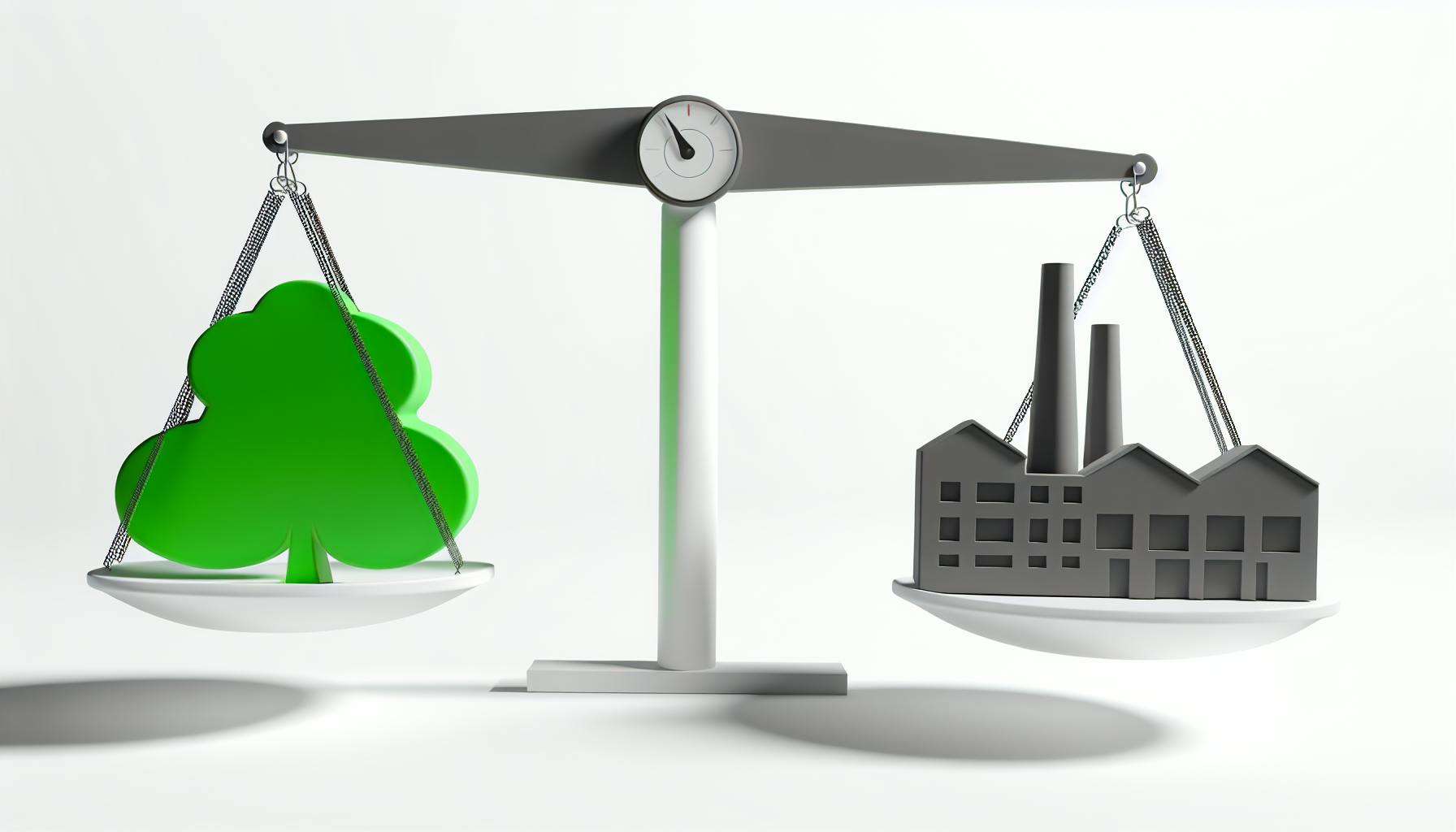Integrating greenhouse gas (GHG) offsets can seem daunting for small and medium enterprises (SMEs).
However, with the right guidance on offset types, procurement processes, and reporting structures, SMEs can effectively incorporate offsets into their operations for sustainability and potential competitive advantage.
This article will provide an informational overview of what GHG offsets are, key offset selection criteria, and practical methods to integrate offsets into your business.**
The Role of GHG Offsets in Sustainable Business Practices
Integrating greenhouse gas (GHG) offsets into business operations can support companies on their journey towards carbon neutrality and environmental sustainability. Offsets help mitigate unavoidable emissions while businesses simultaneously work to reduce their carbon footprint across direct operations and supply chains.
Understanding GHG Offsets and Carbon Credits: Basics Explained
- GHG emissions refer to the release of greenhouse gases like carbon dioxide and methane into the atmosphere from human activities. Major sources include burning fossil fuels, industrial processes, agriculture, and land use changes.
- Carbon offsets fund external projects that reduce, avoid, or sequester GHG emissions to counterbalance emissions from other activities. Each offset represents one tonne of CO2e emissions reduced or removed.
- Carbon credits refer to the tradeable assets generated once a carbon offset project's emissions reductions have been verified to the proper standards. Companies can purchase these credits to compensate for their own emissions.
Establishing a Carbon Footprint Baseline for Your Business
Before purchasing offsets, businesses should calculate their overall GHG emissions, referred to as their carbon footprint. This provides a baseline to track reductions and identify priority areas to address operationally. Use established protocols like the GHG Protocol to calculate Scope 1, 2, and 3 emissions sources.
The Business Case for Carbon Offsetting: Motivations and Benefits
Integrating offsets serves both internal financial motivations and external reputational motivations:
- Mitigate operational risks related to carbon pricing, regulation, or market shifts
- Meet investor and customer expectations for climate action
- Enhance brand reputation and marketing advantages
- Reduce expenses by optimizing energy, materials, and resource efficiency
Setting Realistic Carbon Reduction and Offset Targets
Set aggressive but achievable short and long-term emissions targets, with offsets allowing flexibility to reach net-zero goals. Referencing climate science, aim to reduce absolute emissions 50% by 2030 and 90-100% by 2050 compared to a baseline year.
Offsets as Part of a Comprehensive Emissions Strategy
While offsets enable carbon neutrality claims in the short term, businesses must also continuously work to reduce their overall emissions through improvements in operations, processes, and supply chains. Offsets should only supplement unavoidable residual emissions after rigorous reductions have been undertaken. High-quality offsets also go beyond carbon sequestration to provide environmental and social co-benefits.
What is GHG offsetting?
GHG offsetting refers to the act of compensating for greenhouse gas emissions from an organization's operations by funding projects that reduce emissions elsewhere. A carbon offset represents one tonne of CO2e (carbon dioxide equivalent) that is avoided, reduced, or removed from the atmosphere to counterbalance emissions that occur at another location.
Some examples of carbon offset projects include:
- Renewable energy generation (e.g. wind, solar)
- Forest protection and reforestation
- Methane capture from landfills or farms
Organizations may purchase carbon offsets on the voluntary market from verified carbon offset providers as part of their net-zero or carbon neutrality goals. Offsets enable companies to mitigate their climate impact while they work to reduce their own emissions over time.
The key benefits of carbon offsets for businesses include:
- Cost-effective method to reduce net emissions
- Option to compensate for difficult-to-decarbonize emissions
- Tool for stakeholder engagement and transparency
However, offsets should only be used after internal emission reductions have been maximized, as they do not eliminate the root source of emissions. When integrated strategically into a broader climate action plan, ghg offsets can play an important transitional role for organizations pursuing ambitious decarbonization targets.
What is an example of carbon offsetting?
Some common examples of carbon offsetting projects include:
- Reforestation - Planting trees to absorb CO2 from the atmosphere. This is one of the most popular and effective offsetting methods.
- Renewable energy - Funding solar, wind, or hydro power projects to displace fossil fuel-based energy generation.
- Agricultural practices - Implementing no-till farming, rotational grazing, or other methods to store more carbon in soils.
- Waste management - Capturing methane emissions from landfills or livestock waste to prevent its release into the atmosphere. Methane is a potent greenhouse gas.
- Carbon capture & storage - Funding direct air capture projects that suck CO2 from ambient air and inject it underground for permanent storage. An emerging offset category.
The most credible and verifiable offsets come from registered projects that follow approved standards and methodologies for quantifying emission reductions. Organizations like Verra oversee many of these programs.
When sourcing offsets, businesses should review project documentation to validate claims and ensure offsets represent real, permanent, and additional emission reductions. Reforestation projects that also conserve biodiversity are an excellent option.
What are carbon removal offsets?
Carbon removal offsets refer to credits that represent the removal of carbon dioxide from the atmosphere to offset emissions that cannot be eliminated.
Some key things to know:
- Carbon removal offsets involve extracting CO2 emissions that are already in the atmosphere, whereas regular carbon offsets prevent new emissions
- Popular carbon removal methods include direct air capture, enhanced weathering, reforestation, soil carbon sequestration and bioenergy with carbon capture and storage
- Carbon removal offsets allow companies to offset their hard-to-abate emissions that are difficult to eliminate through energy efficiency, renewable energy procurement, etc.
- High-quality carbon removal credits and projects follow strict standards and verification processes to ensure the carbon removal is permanent and additional
Businesses aiming for net zero emissions need a portfolio of reduction and removal solutions. While companies should focus heavily on cutting emissions from operations and supply chains, carbon removal offsets provide a critical tool for neutralizing remaining emissions on the path to net zero goals.
Integrating ghg offsets like high-quality carbon removal credits into existing emissions reporting and offsetting programs can help businesses accelerate progress and engage stakeholders on ambitious climate action.
sbb-itb-0f1f828
What is the difference between carbon credits and offsets?
Carbon offsets and carbon credits both aim to reduce greenhouse gas emissions, but work in slightly different ways.
The key differences are:
- Carbon credits are part of a cap-and-trade system that sets a limit on emissions, requiring companies to hold credits to cover their emissions. Companies that reduce emissions can sell excess credits to those that need more. This creates a market price for emissions.
- Carbon offsets allow companies and individuals to pay others to absorb or avoid equivalent emissions elsewhere to compensate for their own emissions. This happens voluntarily through carbon offset providers rather than as part of a mandated system.
For example, a company could purchase carbon offsets to support a reforestation project. As the new trees grow, they would absorb CO2 from the atmosphere to compensate for the company's own emissions.
Offsets let entities take responsibility for emissions they can't easily reduce right away. Credits create incentives to drive down overall emissions within sectors covered under cap-and-trade systems.
In practice, the two approaches work best hand-in-hand - offsets supplementing areas not covered under credit schemes. This way, both individuals and industry take positive climate action.
Choosing the Right Carbon Offset Partners
Businesses aiming to achieve net-zero emissions often turn to carbon offsets to mitigate their residual emissions. However, the offset market landscape can be complex to navigate with many providers available. This section offers guidance on partner selection criteria and standards for credibility.
Overview of Carbon Credit Organizations and Standards
Major carbon credit standards like Gold Standard and Verra's VCS provide frameworks for validating and verifying offset projects. They issue serialized credits that get retired to prevent double counting. Registries like Verra's VCS track credit issuance and transfers. Key players in the offset space include:
- Verra VCS - Most widely used standard with over 1600 registered projects. Known for strong transparency, oversight and methodologies.
- Gold Standard - Emphasizes projects with community and environmental benefits. Used by over 80 global brands.
- American Carbon Registry - ANSI accredited standard popular in North America.
Understanding Different Types of Carbon Offsets
Offset projects fund activities reducing or avoiding GHG emissions, generating credits for each tonne avoided. Major project types include:
- Renewable energy - Building solar, wind or hydro power instead of fossil fuel plants.
- Fuel efficient cookstoves - Distributing clean burning stoves to remote communities.
- Forest conservation - Protecting forests from deforestation and degradation.
- Methane capture - Converting methane from landfills and farms into clean energy.
Each offers unique sustainability benefits beyond emissions reductions.
Criteria for Credible Carbon Offsetting Companies
When reviewing offset partners, key credibility indicators include:
- Additionality - Projects must prove added benefit beyond a baseline scenario.
- Validation - Evidence the project meets standards set by carbon credit organizations.
- Community involvement - Ensuring local populations get fair shares of the benefits.
- Permanence - For forestry, guarantees that stored carbon won't be released back.
- Avoiding double counting - Credits should be retired or cancelled post-sale.
- Co-benefits - What other sustainability impacts has the project achieved?
Comparing Carbon Offset Providers: Services and Capabilities
Specialized resellers like EcoHedge aggregate offsets from multiple project developers and provide value-added services for purchasing and reporting. Others like Nori focus specifically on certain project types and locations. Weigh factors like:
- Project portfolio - Range of project types available
- Purchase models - Prepaid, subscriptions, spot pricing
- Retail vs. wholesale - Batch sizes and minimum order values
- Reporting - Integration capabilities and emissions tracking
Carbon Offsets Purchase Models and Their Pricing
Common purchasing options include:
- Prepaid - Buy a set number of offsets upfront at fixed rate.
- Subscription - Offsets supplied monthly or annually at agreed rates.
- Spot pricing - Buy offsets at current market prices, which fluctuate based on demand.
- API integration - Automated purchasing based on emissions data.
Offset prices range widely based on standard, project type, vintage, etc. Expect to pay $5-15 per tonne for credits verified under strong standards. Marketplace models like Nori offer dynamic bidding.
Evaluating potential partners requires balancing offset quality, pricing models, and service capabilities like EcoHedge's automated carbon accounting. This enables embedding credible offsets within your existing workflows to underpin your net-zero journey.
Operationalizing Carbon Offsets Within Your Business
Integrating carbon offsets into business operations can be an effective way for companies to reduce their climate impact. Here are some best practices for seamlessly incorporating offsets across key functions.
Seamless Procurement and Carbon Offsets Integration
- Connect your accounts payable system directly to offset platforms to automatically reconcile emissions and trigger offset purchases. This ensures offsets are handled similarly to other expenses.
- Set up workflows to calculate emissions on a regular basis (e.g. monthly, quarterly) and execute corresponding batch offset transactions.
- Tag offset expenses with a dedicated GL code for tracking over time. Allocate across departments based on contribution analyses.
Dashboard Development for Tracking Carbon Credits and Offsets
- Build a dashboard in BI tools like Tableau to aggregate emissions data and connect to offset purchase records.
- Visualize emission trends, offset transactions, budget vs actual spending, and progress to carbon neutrality goals.
- Automate dashboard updates by connecting datasets to SQL or an integrated data warehouse.
Incorporating Carbon Offsets into Product Lifecycle Management
- For product companies, use lifecycle analysis data to estimate emissions per unit sold.
- Integrate with ecommerce platforms via API to automatically trigger offset purchases as customer transactions occur.
- Show offset contributions on customer receipts and product pages to showcase commitment.
Showcasing Your Carbon Offset Efforts Publicly
- Prominently display carbon neutrality status and offset contributions on company website and annual reports.
- Provide downloadable receipts substantiating offset transactions to reinforce transparency.
- Feature case studies demonstrating how offsets enable delivering carbon neutral products/services.
Streamlining Carbon Offsets Reporting for External Audiences
- Consolidate offset provider reports into overall GRI, CDP, DJSI and other ESG disclosures for simplified delivery to stakeholders.
- Tag offset expenses with relevant taxonomy classifications to power integrated reporting across frameworks.
- Automate report aggregation each period using scripting or an integrated sustainability platform.
Incorporating carbon offsets strategically within businesses enables companies to effectively mitigate emissions today while pursuing aggressive decarbonization programs for long term carbon neutrality. Seamless integration across key workflows and functions ensures offsets are handled systematically alongside day-to-day operations. Transparent reporting also reinforces environmental commitments to both internal and external stakeholders.
Leveraging Carbon Offsets for Business and Environmental Impact
Carbon offsets provide businesses an opportunity to reduce their climate impact in a flexible and cost-effective way. By funding projects that reduce greenhouse gas emissions, companies can counterbalance emissions from their own operations that are difficult to eliminate directly.
Integrating high-quality offsets into a business strategy alongside internal emission reductions creates a comprehensive approach to achieving carbon neutrality goals and enhancing sustainability credentials.
Innovation and Competitive Advantage Through Carbon Offsetting
The process of deeply analyzing a company's carbon footprint, researching offset options, and designing an offset purchasing strategy encourages fresh thinking that can stimulate innovative ideas across the business.
Some examples of potential innovations unlocked by offsetting include:
- Identifying efficiency upgrade opportunities through examining emissions data
- Re-engineering manufacturing processes to use less carbon-intensive materials
- Tweaking product design to optimize end-of-life recycling
- Evolving supply chain logistics to reduce transport emissions
Pursuing carbon neutrality through offsets proactively positions companies competitively as climate regulations expand. It also allows branding and marketing focused on leadership in sustainability.
Enhancing Stakeholder Engagement with Carbon Offset Examples
Communicating the details and impacts of funded offset projects to stakeholders creates shared value and showcases commitment to tackling climate change.
For customers, offset project stories on packaging or websites increase connection to brands focused on purpose beyond profits. Investors appreciate transparency and future-proofing strategies like offsetting. Policymakers welcome voluntary climate action from business rather than regulation alone. Communities benefit through local schools, forests, and clean energy supported by offset dollars.
Preparing for the Future: Carbon Offsets vs Carbon Credits
Experience gained now researching offsets builds organizational knowledge to navigate complex emerging regulated carbon markets.
As pressure increases on corporations from investors and regulators to dramatically decarbonize this decade, understanding offsets facilitates the transition to more stringent cap-and-trade emissions trading systems reliant on carbon credits.
The offset expertise developed today serves as the blueprint for the carbon management infrastructure to seamlessly adopt credits mechanisms in the future across operations.
Summarizing the Path to Carbon Neutrality with GHG Offsets
For SMEs seeking carbon neutrality, high-quality offsets integrated with internal reductions provide flexibility in meeting goals. Offsetting stimulates fresh ideas across the business while allowing stakeholders a window into climate action.
Getting started analyzing footprints, choosing offsets, and communicating impacts prepares companies for even more ambitious regulations certain to expand. Constructing robust carbon accounting and offsetting systems now future-proofs organizations for smooth transitions to carbon-constrained business environments ahead.
The path to neutrality coupled with purpose-driven branding builds competitive edge. Factor in cost savings from efficiency innovations revealed through offsetting processes, and the business case compounds further.
Carbon neutrality powered by offsets equals lower risks, greater opportunities, and branding tailwinds for forward-focused SMEs. Those seizing leadership today are best positioned to thrive as sustainable business practices become standard - and required - practice.



